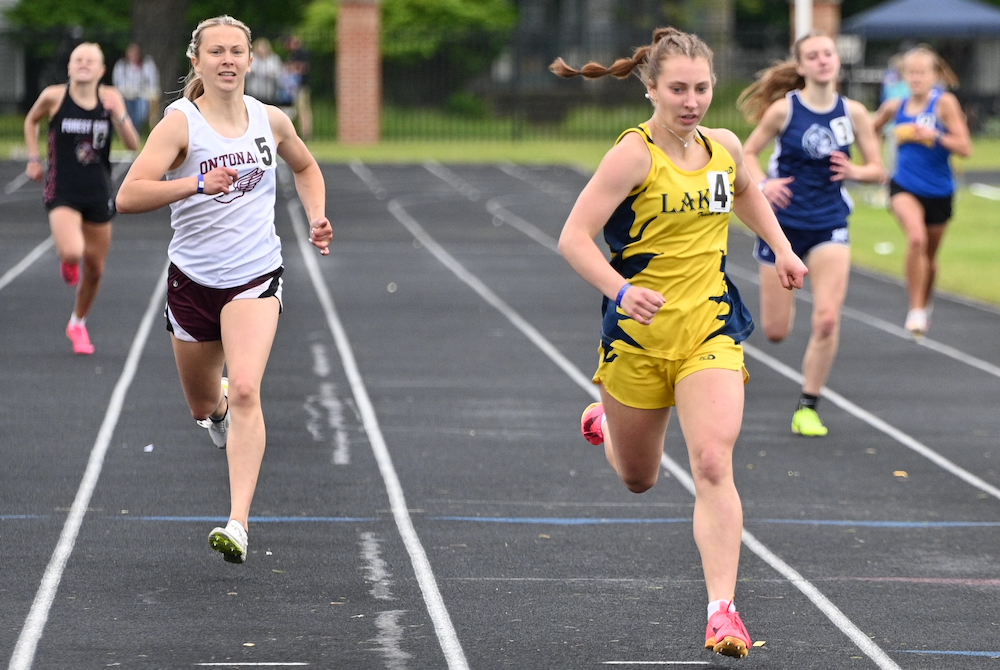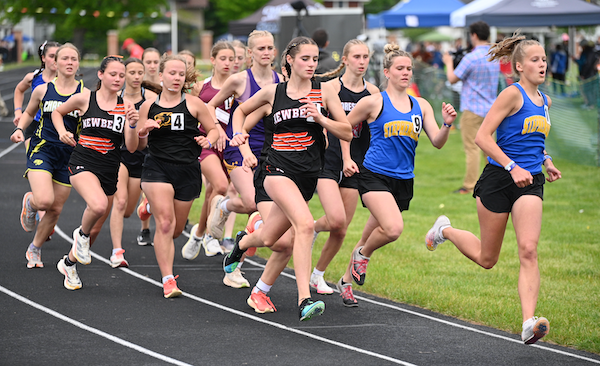
New Math: Division & Multiplication Problems
July 25, 2017
By Jack Roberts
MHSAA Executive Director
This is the second part in a series on MHSAA tournament classification, past and present, that will be published over the next two weeks. This series originally ran in this spring's edition of MHSAA benchmarks.
High school tournament classifications went viral before there was social media and most of us knew what “viral” meant.
Much as a virus infects computers today or has created epidemics of disease around the world for centuries, high school tournament classification – once introduced – tends to spread uncontrollably. Once started, it tends to keep expanding and rarely contracts.
While we are still some distance from providing every team a trophy as a result of expanding high school tournament classification across the country, there is criticism nevertheless that we are headed in that direction – a philosophy which is supposed to exist only in local youth sports for our youngest children.
Michigan could be blamed for all this. Michigan is generally accepted as the first state to provide different classifications for season-ending tournaments for different sized schools. It started a century ago. Today, every state has various classifications for its tournaments in most if not all sports. And it is a bit ironic that Michigan – creator of the classification chaos – more than most other states has kept the number of tournament classes or divisions under control.
Yes, there is evidence that tournament classifications have expanded over the years in Michigan, especially with the relatively recent introduction of tournaments in football and the late 1990s’ move from classes to divisions in most MHSAA tournaments. But the MHSAA Representative Council has held true to its word when it expanded the playoffs for football from four classes to eight divisions: this is needed because of unique factors of football, factors that exist in no other sport; and all other sports should be capped at a maximum of four classes or divisions.
Kentucky is the preeminent defender of single-class basketball. All of its 276 high schools compete for the single state championship for each gender. In Indiana, there are still open wounds from its move in 1998 from one to four classes for its 400 schools in basketball.
Multi-class tournaments have tended to increase the number of non-public school champions, which some states are trying to lower through enrollment “multipliers,” and also tend to increase the number of repeat champions, which some states are trying to affect with “success factors” which lift smaller schools into classifications for larger schools if they take home too many trophies.
While there is considerable evidence that state tournaments do as much bad as good for educational athletics, state associations persist in providing postseason tournaments because, on balance, the experiences are supposed to be good for student-athletes. And once we reach that conclusion it is just a small leap to believe that if the tournaments are good for a few, they must be better for more – which leads to creating more and more tournament classifications. One becomes two classes, then three, then four and so forth.
While the argument is that more classifications or divisions provides more students with opportunities to compete and win, it is undeniable that the experience changes as the number of tournament classifications expands. It is not possible for state associations to provide the same level of support when tournament classifications expand to multiple venues playing simultaneously. For example, there is less audio and video broadcast potential at each venue, and less media coverage to each venue. Focus is diluted and fans diminished at each championship.
No one can argue reasonably that today's two-day MHSAA Football Finals of eight championship games has the same pizazz as the one-day, four-games event conducted prior to 1990.
In some states the number of divisions has grown so much that it is difficult to see much difference between the many season-ending state championship games and a regular-season event in the same sport.
It is a balancing act. And Michigan has been studying that balance longer than any other state, and charting a steadier course than most.
Addition by Division
The shift to Divisions for MHSAA Tournament play in numerous sports has added up to a greater number of champions for teams and individuals across the state. Following are the sports currently employing a divisional format, and the procedures for determining enrollment and classification.
In 23 statewide or Lower Peninsula tournaments, schools which sponsor the sport are currently divided into nearly equal divisions. They are:
- Baseball - 4 Divisions
- Boys Bowling - 4 Divisions
- Girls Bowling - 4 Divisions
- Girls Competitive Cheer - 4 Divisions
- LP Boys Cross Country - 4 Divisions
- LP Girls Cross Country - 4 Divisions
- LP Boys Golf - 4 Divisions
- LP Girls Golf - 4 Divisions
- Ice Hockey - 3 Divisions
- Boys Lacrosse - 2 Divisions
- Girls Lacrosse - 2 Divisions
- Boys Skiing - 2 Divisions
- Girls Skiing - 2 Divisions
- LP Boys Soccer - 4 Divisions LP
- Girls Soccer - 4 Divisions
- Girls Softball - 4 Divisions
- LP Boys Swimming & Diving - 3 Divisions
- LP Girls Swimming & Diving - 3 Divisions
- LP Boys Tennis - 4 Divisions
- LP Girls Tennis - 4 Divisions
- LP Boys Track & Field - 4 Divisions
- LP Girls Track & Field - 4 Divisions
- Wrestling - 4 Divisions
Lists of schools for each division of these 23 tournaments are posted on MHSAA.com approximately April 1. Listings of schools in Upper Peninsula tournaments for their sports are also posted on MHSAA.com. The lists are based on school memberships and sports sponsorships in effect or anticipated for the following school year, as known to the MHSAA office as of a date in early March.
In football, the 256 schools which qualify for MHSAA 11-player playoffs are placed in eight equal divisions annually on Selection Sunday. Beginning in 2017, the 8-player divisions will be determined in a like manner on Selection Sunday as well, with 32 qualifying schools placed in two divisions.
Schools have the option to play in any higher division in one or more sports for a minimum of two years.
The deadlines for "opt-ups" are as follows:
- Applications for fall sports must be submitted by April 15
- Applications for winter sports must be submitted by Aug. 15
- Applications for spring sports must be submitted by Oct. 15
Subsequent to the date of these postings for these tournaments, no school will have its division raised or lowered by schools opening or closing, schools adding or dropping sports, schools exercising the option to play in a higher division, or approval or dissolution of cooperative programs.
When the same sport is conducted for boys and girls in the same season (e.g., track & field and cross country), the gender that has the most sponsoring schools controls the division breaks for both genders.

Jokela Stars Again, Lake Linden-Hubbell Reigns This Time as Outright Champ
By
John Vrancic
Special for MHSAA.com
June 2, 2024
KINGSFORD — Lake Linden-Hubbell junior Emily Jokela had quite a workout here Saturday and has three individual victories to show for it.
The Lakes also benefitted from her effort as they earned the Upper Peninsula Division 3 track & field team championship.
LL-H, which shared the title with Stephenson a year ago, scored 72 points this time. Newberry edged Stephenson 64-62 for the runner-up trophy.
“Our Regional has been tough since 2016,” Lakes’ coach Gary Guisfredi said. “Since that time, teams from our Regional have won the U.P. Finals eight times. Emily scored 38 points alone today. Our shot putter (sophomore Maddy Dudenas) taking third and our girl (sophomore Cleo Milkey) taking fourth in long jump were big points. We knew Newberry and Stephenson were going to be tough.”
Jokela opened with a victory in the 100-meter dash in 13.04 seconds. Later, she set UPD3 Finals records in back-to-back races, taking the 400 (58.61) and 300 hurdles (44.8) prior to placing second in the 200 (27.03).
“My starts were better than usual,” she said. “Those (open 400 and 300 hurdles) are tough races, but you just got to push through that. You always try to prepare for that in practice. I just try to beat everybody to the next hurdle.”
Her effort in the 400 topped the old mark (58.7) by Superior Central’s Lauren Spranger in 2011, and in the hurdles she bested her own record (45.63) from a year ago.
The Lakes, who finished undefeated this year, also won the 800 relay at 1:52.52.
 “I think our handoffs were good,” senior Rebecca Lyons said. “It feels great to be U.P. champions. We were really excited about this meet. We knew Newberry and Stephenson were pretty good.”
“I think our handoffs were good,” senior Rebecca Lyons said. “It feels great to be U.P. champions. We were really excited about this meet. We knew Newberry and Stephenson were pretty good.”
Dollar Bay got a first on sophomore Kiera Isaacson’s leap of 5-3 in high jump.
Newberry, coming off a solid cross country season from last fall, showed its strength in the distances. Sophomore Samantha Taylor set the meet record in the 1,600 (5:14.9), topping the previous best (5:17.2) by Amy Kerst of Munising in 2011. She was followed by freshman Abby Taylor (5:22.7), Stephenson sophomore Faith Cappaert (5:36.7) and Newberry senior Kaylen Clark (5:37.49), who will run at Davenport University this fall.
Clark added a first in the 3,200 (12:33.7), withstanding a challenge from North Dickinson’s Mya Grunlund (12:43.65).
“I knew I had my kick and had to use it today,” Clark said. “I just wanted to defend my title one more time. I think my conditioning from cross country helped me. I missed three meets because of bronchitis. Once I got over that, I did a lot of slow miles. It was a struggle.
“I’ll get to run against Lola (Korpi) again in college. I’m real excited about that. It will also be exciting to do something new.”
Newberry also overcame a slow start to win the 3,200 relay (10:24.16).
“We weren’t too worried,” Abby Taylor said after anchoring that relay. “We knew Kaylen and Sam would close it. I felt pretty relaxed and confident in the final leg.”
Cappaert won the 800 (2:25.91), followed by Abby Taylor (2:33.34) and Clark (2:35.52), and senior Kayela Putnam added a first for the Eagles in pole vault (10-0).
Fourth-place Carney-Nadeau got the bulk of its points in the field events where senior Samantha Kedsch set a meet and school record in long jump at 16-11. Her effort also topped the previous best jump of 16-7½ by Ontonagon’s Olivia Suomis in 2012.
Junior teammate Mariska Laurila won discus with a school-record throw of 114-1 and added a first in shot put (33-1¼), with senior Kelsie Smith taking second (32-5).
Big Bay de Noc got a first from Destiny Bleau, who was clocked at 26.73 in the 200.
PHOTOS (Top) Lake Linden-Hubbell's Emily Jokela sets a meet record in the 400 with a winning time of 58.61 on Saturday. (Middle) Stephenson's Faith Cappaert (11) takes the lead and doesn't relinquish it while winning the 800. (Click for more from Cara Kamps/RunMichigan.com.)

